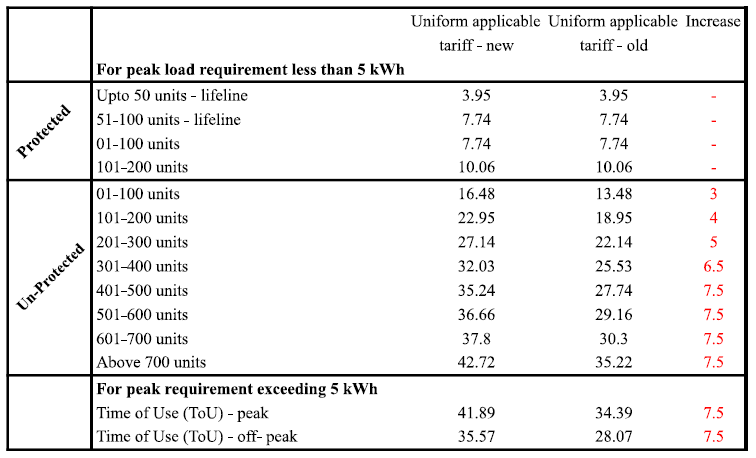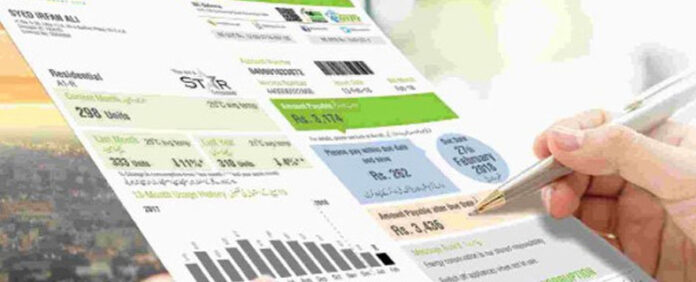Looking at your electricity bill every month can be a daunting task. You may have spent that entire month trying to bring down your electricity use and even though the number of units may be lower than the previous month’s, the bill still appears to be higher and you are not sure why.
Profit breaks down the different categories in your electricity bills, what they refer to, and how you can calculate your bill yourself. For this story, only the bills of residential consumers under the AR-1 tariff will be explained.
Bills are divided into two parts — amounts payable to the distribution companies (DISCOs) and amounts payable to the government.
The National Electric Power Regulatory Authority (NEPRA) determines both the tariff for each DISCO as well as a uniform tariff based on the government’s proposals, which also incorporates subsidies and inter-DISCO tariff rationalisation/cross-subsidies — so that consumers of all DISCOs end up paying the same amount irrespective of the cost of electricity for each DISCO.
The authority recently raised the price of electricity by up to Rs 7.5 per unit effective July 1, 2023, after holding a hearing on a motion filed by the federal government.
There are different categories of consumers — protected (lifeline), protected, unprotected and those that have Time of Use (ToU) meters. Residential consumers having a single-phase electricity connection with a sanctioned load of 1 kilowatt per hour (kWh) — you can check your sanctioned load on your bill — including non-ToU consumers who have used less than 100 units a month for the last 12 months are lifeline consumers.
Consumers who use up to 200 units consistently for six months are protected consumers. If the consumption goes above 200 units for even a month and the streak is broken, the consumers will become part of the unprotected category.
Consumers that have a sanctioned load of 5 kWh or higher have ToU meters, which are also known as variable rate meters. These meters have two separate numerical displays — for off-peak hours and on-peak hours (typically during the evenings and nights). Thus, there are two different tariffs for them — off-peak and on-peak, the timings for which differ for each DISCO and season.

The bulk of the charges in the DISCOs section is attributed to the cost of electricity, which you can calculate by multiplying the number of units used with the power tariff.
After this, we have the Quarterly Tariff Adjustment (QTA) and the Fuel Charge Adjustment (FCA)/Fuel Price Adjustment (FPA). At times, the cost of electricity provided to customers by the DISCO is less or more expensive than the amount charged for it. There can be different reasons for this, including a higher cost of power generation due to raised prices of fuel in the international market. In such a case, the DISCO files a petition with NEPRA to recover that amount by charging the customers the difference in a bill for a later month.
So, for example, in your bill for July 2023, you might see that you have been charged a certain amount per unit for the electricity you used in May. Keep in mind that the FCA/FPA or the QTA is charged for the units you have already used in that month or quarter, instead of your units in the latest month. If you want to check whether the charges are correct, you can go through NEPRA’s decision, which is uploaded to its website.
You may also see additional surcharges, such as the one for Power Holding Limited (PHL) in the K-Electric bill or Finance Cost (FC) Surcharge in the Islamabad Electric Supply Company (IESCO) bill. These surcharges go towards reducing the power sector’s debt servicing and circular debt.
The PHL, which is under the control of the Ministry of Energy’s Power Division, was founded in 2009 to reduce the power sector’s liabilities by borrowing from financial institutions. This is essentially the customer paying for the loan markup.
The government has previously stated that the revenue earned from electricity sales was insufficient to cover PHL loan markups, and hence, it requested NEPRA to impose the additional surcharges. The regulator’s decisions in this regard are also available on its website.
According to NEPRA’s decision, a surcharge of 43 paise for consumers using up to 300 units a month and Rs3.82 for all others, was applicable from March 1 to June 30. It will be charged throughout the current fiscal year (till June 2024) at a rate of Rs 1.43 per unit.
Now, we come to the amount payable to the government, the first of which is the electricity duty. A duty of 1.5 percent is charged on the cost of electricity, the QTA and the FCA/FPA, and distribution margins.
Furthermore, a sales tax of 18 percent is charged on the cost of electricity, the quarterly tariff adjustment, fuel charge adjustment and distribution margins, the electricity duty and the FC surcharge.
Besides this, a flat fee of Rs 35 is charged for Pakistan Television (PTV). The government is also considering imposing a Rs 15 radio fee that would be used to pay Radio Pakistan employees. However, a decision in this regard is yet to be taken.
In case, you are not a filer and your name is not on the Active Taxpayers List (ATL), you will also have to pay income tax. According to the Income Tax Ordinance, you will not have to pay any income tax if your bill is below Rs 25,000. However, if your bill is above Rs 25,000, you will have to pay an income tax of 7.5 percent of the total amount.
Despite the recent increase in tariff rates, the government has stated that 63 percent of residential consumers would not see any change in their electricity bills as it was offering subsidies of Rs 158 arab as well as cross-subsidising by charging those who use more units higher rates.
During NEPRA’s hearing on the federal government’s motion to “reconsider and issue” the new uniform tariff, representatives of the Power Division had claimed that 98 percent of consumers would still be subsidised to differing degrees.
Pakistan’s energy sector is in a perennial crisis with its circular debt — a cash shortfall across the power supply chain that is accrued when power purchasers fail to pay power producers — standing at Rs 2.65 kharab at the end of May.
The government’s move to impose the finance cost surcharge was an attempt to reduce this circular debt as a growing circular debt threatens the viability of the entire energy sector. While the government has increased the uniform tariff, some analysts say that instead of reducing the circular debt, the move may encourage power theft and decrease consumption, thereby affecting the economic output.


























word games are games that is not difficult. But it’s not easy either, It’s better when you play it with your friend. You’ll see an incredible level of word search. Puzzles will be solved twice as fast as usual that is not difficult
I have been searching for a way to get my eBooks on my kindle for SOOO LONG!!! This was so helpful, THANK YOU!
if consumption is more than 25000 unit what is electricity bill
Highly greateful to urooj Imran to provide a very informative article to the poor people to understand their electric bill. Once again thanks alot🤲🌷
Excellent article. Thanks for sharing.
Understanding your electricity bill amidst the backdrop of expensive energy is crucial. From kilowatt-hour rates to distribution charges, deciphering the intricacies is daunting. A grasp of consumption patterns empowers cost-saving measures. Exploring book trailer services can simplify this process, offering engaging visuals and explanations, aiding in comprehension and informed energy usage decisions.
Understanding your electricity bill can be as crucial as a pre-employment physical exam. It’s about knowing what you’re paying for. Expensive energy costs can be mitigated by understanding the charges on your bill, from usage rates to service fees. This knowledge can lead to significant savings.
Understanding your electricity bill is crucial in the era of expensive energy. It involves knowing the different charges and what they mean. Just like understanding the “Pre Employment Physical Exam cost”, it’s important to be aware of where your money is going.
Understanding your electricity bill can be as complex as planning a menu with a culinary consultant in Vancouver, Canada. Both require a deep understanding of various factors. In the case of energy, it’s about knowing the costs, usage rates, and potential savings.
Your blog is my go-to place for all things cozy and crafty! Thanks for sharing this informative blog! Looking forward to read more content like this.
Welcome to our digital haven! Here, we embark on a journey of exploration, curiosity, and knowledge-sharing. Join us as we dive into the depths of diverse topics, uncovering insights, igniting discussions, and fostering connections. Together, let’s embark on this exhilarating voyage of discovery and enlightenment!
In today’s world, where the cost of living is ever-rising, understanding your electricity bill is more important than ever. “Expensive energy: Everything you need to know to understand your electricity bill” serves as an essential primer for anyone looking to demystify the complexities of their energy expenses.
The keyword Balance And Harmony For Life is particularly apt when discussing energy consumption. It’s about finding the right equilibrium between usage and cost, ensuring that our daily activities do not lead to financial strain. This guide breaks down the various components of an electricity bill, empowering consumers with the knowledge to make informed decisions.
Understanding your electricity bill is as crucial as choosing the right Massapequa dentist for your dental care. This guide illuminates the complexities of energy expenses, ensuring you’re informed and can make savvy decisions about your household consumption. Knowledge is power, especially when it’s about energy.
“In a world where car window replacement is more urgent than ever, understanding your electricity bill becomes essential. Let’s steer clear of clichés like ‘artistry’ and ‘handiwork.’ Instead, focus on the practical components: supply and distribution charges. Divide your bill by total consumption to grasp its impact. Lower costs by exploring solar options!”
Electricity bills can be hard to decipher. Some bills are detailed, others succinct. Understanding your bills and why your utility charges different fees is crucial to saving energy and costs. Plus, explore our Chassis Number Check online for Japanese car history insights—no crafting required!